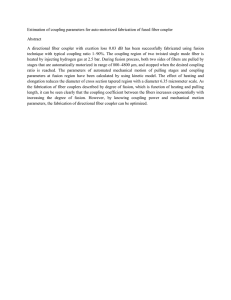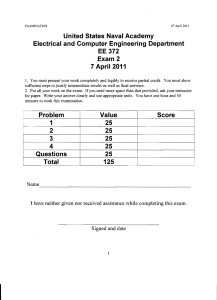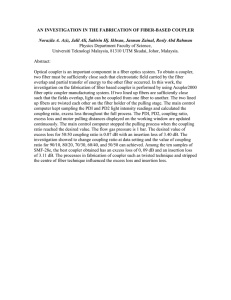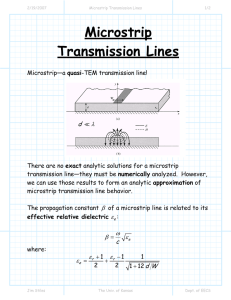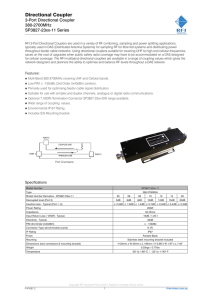Design and fabrication of 12 GHZ microstrip directional coupler for
advertisement
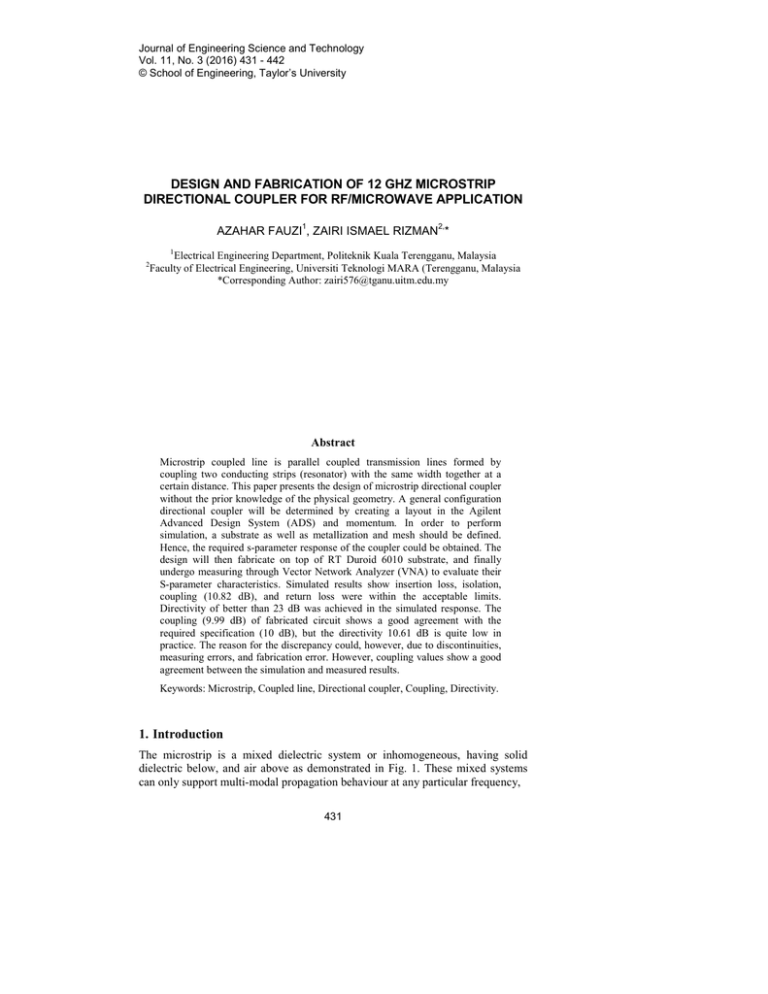
Journal of Engineering Science and Technology Vol. 11, No. 3 (2016) 431 - 442 © School of Engineering, Taylor’s University DESIGN AND FABRICATION OF 12 GHZ MICROSTRIP DIRECTIONAL COUPLER FOR RF/MICROWAVE APPLICATION AZAHAR FAUZI1, ZAIRI ISMAEL RIZMAN2,* 1 2 Electrical Engineering Department, Politeknik Kuala Terengganu, Malaysia Faculty of Electrical Engineering, Universiti Teknologi MARA (Terengganu, Malaysia *Corresponding Author: zairi576@tganu.uitm.edu.my Abstract Microstrip coupled line is parallel coupled transmission lines formed by coupling two conducting strips (resonator) with the same width together at a certain distance. This paper presents the design of microstrip directional coupler without the prior knowledge of the physical geometry. A general configuration directional coupler will be determined by creating a layout in the Agilent Advanced Design System (ADS) and momentum. In order to perform simulation, a substrate as well as metallization and mesh should be defined. Hence, the required s-parameter response of the coupler could be obtained. The design will then fabricate on top of RT Duroid 6010 substrate, and finally undergo measuring through Vector Network Analyzer (VNA) to evaluate their S-parameter characteristics. Simulated results show insertion loss, isolation, coupling (10.82 dB), and return loss were within the acceptable limits. Directivity of better than 23 dB was achieved in the simulated response. The coupling (9.99 dB) of fabricated circuit shows a good agreement with the required specification (10 dB), but the directivity 10.61 dB is quite low in practice. The reason for the discrepancy could, however, due to discontinuities, measuring errors, and fabrication error. However, coupling values show a good agreement between the simulation and measured results. Keywords: Microstrip, Coupled line, Directional coupler, Coupling, Directivity. 1. Introduction The microstrip is a mixed dielectric system or inhomogeneous, having solid dielectric below, and air above as demonstrated in Fig. 1. These mixed systems can only support multi-modal propagation behaviour at any particular frequency, 431 432 A. Fauzi and Z. I. Rizman Nomenclatures C dB E F GHz H l/L S s S11 S21 S31 S41 W Zo Zoe Zoo Coupling, dB Decibel Electric field, V/m Centre frequency, GHz Giga hertz Substrate thickness, mm Length, mm Scattering parameter Spacing, mm Return loss, dB Coupled signal, dB Isolation , dB Transmitted signal (transmission) Width, mm Output impedance, Ω Even-mode output impedance, Ω Odd-mode output impedance, Ω Greek Symbols βe Even-mode phase constant βo Odd-mode phase constant εr Substrate permittivity, As/Vm Γe Even-mode reflection coefficient Γo Odd-mode reflection coefficient Abbreviations ADS MCLIN MLIN PCB SMA TEM VNA VSWR Advanced Design System Microstrip Coupled Line Microstrip Line Printed Circuit Board SubMiniature version A Transverse Electro-magnetic Vector Network Analyzer Voltage Standing Wave Ratio due to the discontinuity in the electric structure. In other words, the structure does not support pure TEM wave. The field patterns in a microstrip are such that the bulk of the energy is transmitted in a TEM like mode, and this approximation is often made, so propagation in microstrip is often referred as ‘quasi-TEM’ [1]. TEM stands for Transverse Electro-magnetic, and means that the electric and magnetic fields are entirely directed in a plane transverse to the direction of propagation. Parallel coupled line couplers are widely used for many wireless and microwave applications because they can be easily implemented and incorporated with other circuits. Microstrip coupled line is parallel coupled transmission lines formed by coupling two conducting strips (resonator) with the same width together at a certain distance, as depicted in Fig. 2 [2]. The odd- and even-mode Journal of Engineering Science and Technology March 2016, Vol. 11(3) Design and Fabrication of 12 GHZ Microstrip Directional Coupler for . . . . 433 characteristic impedance can be analyzed by individual even-mode and odd-mode circuits. It should be noticed that, phase velocity of even-mode is greater than odd-mode phase velocity due to more of the odd-mode electric fields (E) travels in the air. Then, the wavelength of individual mode is absolutely different from each other [3]. Conductor w Dielectric h Ground Plane Fig. 1. Microstrip line. Fig. 2. Top view of two port parallel coupled line. The analysis of a coupled transmission line can be described by S-parameter in order to observe the coupling characteristics. As shown in Fig. 3, all ports are labelled, and are all terminated in the system characteristic impedance Zo. In this case, it is assumed that the two lines have the same characteristic impedance, and so the whole structure is symmetrical. If port 1 is the input port, then the characteristics can be determined by derivation based on the four ports, as shown in Eq. (1). S 11 = b1 b2 b3 b4 , S 21 = , S 31 = , S 41 = a1 a1 a1 a1 (1) where S11 is the return loss, S21 is the coupled signal, S31 is the isolation and S41 is the transmitted signal (transmission). Each of even-mode and odd-mode has associated characteristic impedance and phase constant, Zoe and βe for the even mode and Zoo and βo for the odd mode. The derivations for the above four parameters are complex and mentioned in many published sources [4-15]. The final definitions are expressed as Eq. (2). Journal of Engineering Science and Technology March 2016, Vol. 11(3) 434 S 11 = A. Fauzi and Z. I. Rizman Γe + Γo Γe − Γo Te − To Te + To , S 21 = , S 31 = , S 41 = 2 2 2 2 (2) where Γe is the even-mode reflection coefficient, Γo is the odd-mode reflection coefficient, Te is the even-mode transmission coefficient and To is the odd-mode transmission coefficient. Fig. 3. Asymmetrically excited pair of coupled line. For the ideal coupler, the value of phase constant of each odd and even mode are similar and S11 = S31 = 0. The power will split between ports 2 and 4 with a 90o phase shift between the signals. This is called a quadrature hybrid coupler. Due to symmetry, power input into port 4 splits between ports 1 and 3 with 90o phase shift, input to port 3 splits between ports 2 and 4, etc [16]. However, when implementing the directional coupler in microstrip transmission line, the effect of phase velocity difference between even and odd mode exhibits poor directivity. The directivity is a measure how well coupler can isolate two signals. Higher directivity results in better measurement accuracy. As a result, it is the most designed parameter for accurate measurement systems. However, it is a great challenge to preserve directivity, amount of desired coupling level, low Voltage Standing Wave Ratio (VSWR) [17] and insertion loss for wideband microwave applications [18]. In this paper, a simple design procedure is used with model approximation formulation. It comprises a complete design of symmetrical two-line microstrip directional coupler. However, the physical length of the coupler is initially unknown. The only information that can be obtained is port impedances, required coupling level, and operational frequency at the initial stage of the design. Thus, this requires several iterations to finalize the design. 2. Design of Directional Coupler The geometry of a parallel coupled line directional coupler is as shown in Fig. 1. As it is outlined in the introduction section, we assume that port impedance Zo, coupling and the operational frequency are known parameters at beginning of the design. The initial specifications for the designed directional coupler are shown in Table 1. Based on the known parameters, the proposed procedure has the following steps. Journal of Engineering Science and Technology March 2016, Vol. 11(3) Design and Fabrication of 12 GHZ Microstrip Directional Coupler for . . . . 435 Table 1. Directional coupler designed specifications. Parameter Coupling, C Centre frequency, f Substrate permittivity, εr (RT Duroid 6010LM) Substrate thickness, h Copper thickness, t Tan δ Value 10 dB 12 GHz 10.2 0.635 mm 17 µm 0.0012 at 10 GHz 2.1. Step 1: Find even and odd mode impedances The equations used in the design are based on transmission line model approximation. The even and odd mode impedances, Zoe and Zoo, of the microstrip coupler can be found as Z oo = Z o X 1 − 10 −C / 20 1 + 10 −C / 20 (3) Z oe = Z o X 1 + 10 −C / 20 1 − 10 −C / 20 (4) where Zo is the network characteristic impedance of 50 Ω [19] and C is the forward coupling requirement in decibels. The value of coupling (C) then substitutes into Eqs. (3) and (4), the values of Zoe and Zoo are 69.37 Ω and 36.04 Ω, respectively. 2.2. Step 2: Agilent ADS simulation All the values and the specifications in Table 1 were included as the data in the Advanced Design System (ADS) electronic software. The software simulated the data and automatically calculated the dimensions of Microstrip Coupled Line (MCLIN) and Microstrip Line (MLIN) by using ‘linecalc’ tool bar. Table 2 shows the dimensions of MCLIN and MLIN. With these geometric dimensions, the physical structure can be modelled with the inventory of the circuit element provided, as shown in Fig. 4. In order to accomplish a best simulation result as specifications required, several iterations had been done accordingly. With the Agilent ADS, its schematics diagram layout is closely integrated with momentum layout of the designed circuits. The layout of directional coupler circuit is automatically generated. Any changes of the schematic diagram will be affected in the momentum layout. Figure 5 shows the momentum layout of passive directional coupler. Table 2. Dimensions of MCLIN and MLIN. Parameter Width, w Length, l Spacing, s MCLIN 0.487239 mm 2.4168 mm 0.239712 mm Journal of Engineering Science and Technology MLIN 0.596374 mm 2.33598 mm March 2016, Vol. 11(3) 436 A. Fauzi and Z. I. Rizman Fig. 4. Schematic diagram of directional coupler. 2.3. Step 3: Directional coupler fabrication As can be seen, several microstrip corner pads have been added in the schematic diagram to avoid coupling effect between arms and also the distance between arms become wider. Hence, the respective arms can attach or connect to the SubMiniature version A (SMA) connector during fabrication [20]. The layout will be printed and fabricated on top of RT Duroid 6010 material with εr = 10.2 and the thickness, h = 0.632 mm. Journal of Engineering Science and Technology March 2016, Vol. 11(3) Design and Fabrication of 12 GHZ Microstrip Directional Coupler for . . . . 437 Fig. 5. Momentum layout of directional coupler. 3. Results and Discussion It is a great challenge to preserve an amount of desired coupling level, high directivity and low insertion loss for microwave applications. The directivity is a measure of how effective the directional coupler is in “directing” the coupled energy into the coupled port, but not into the isolation port. Ideally, directivity is infinite, so the higher the directivity, the better the device is. Fig. 6. Simulated result of directional coupler. Journal of Engineering Science and Technology March 2016, Vol. 11(3) 438 A. Fauzi and Z. I. Rizman As simulated result shown in the Fig. 6, the value of coupling (S21) is 10.819 dB at 12 GHz. It is slightly greater than of the required coupling specification. The differences in coupling factor due to the physical length, width, and spacing between microstrip of the directional coupler circuit computed from simulation process compared with design procedure with accurate formulation. Furthermore, the design procedure only depends on the knowledge of required coupling level, the port impedances that directional coupler will be connected to, and operational frequency [21]. However, all the results such as insertion loss, isolation, coupling and return loss were within the acceptable limits. Directivity of better than 23 dB was achieved in the simulated response. Furthermore, the error of coupling factor of the simulated result compared to required specifications is 8.19% and is considerably small. Fig. 7. Directional coupler fabricated circuit. In order to prove the design, a coupler corresponding to Fig. 5 is fabricated on RT Duroid 6010 substrate as per photograph given in Fig. 7. The fabrication was measured by using Vector Network Analyzer (VNA) [22], as shown in Figs. 8, 9, and 10. Isolation is plotted instead of directivity to give better graphical view and directly be calculated at any point by subtracting coupling factor from it [23]. There is a good agreement between the simulation results and measured one. It can be seen clearly that measured coupling (9.99 dB) shows a better result compared to simulated result and almost fulfil the specification requirement (10 dB). In spite of that, the isolation response (20.6 dB) of measured coupler indicates lower performance compared to the simulated result (about 34 dB). By subtracting the measured result between isolation and coupling, the result exhibits low directivity (10.61 dB) which is not suitable for measurement systems accuracy. The reason for the discrepancy could, however, due to discontinuities and measuring errors which are not taken into account [24]. Error in fabrication could be another possible source of discrepancies to the measured result. The difficulty encountered in fabrication is to ensure that the thickness of copper conductor exactly at 17 µm according to the simulation done earlier and also as notified in the standard procedure. As the printing carried out, the copper thickness and pattern follow the screens that had been produced earlier. Journal of Engineering Science and Technology March 2016, Vol. 11(3) Design and Fabrication of 12 GHZ Microstrip Directional Coupler for . . . . 439 Fig. 8. Isolation result. Fig. 9. Insertion loss result. Journal of Engineering Science and Technology March 2016, Vol. 11(3) 440 A. Fauzi and Z. I. Rizman Fig. 10. Coupling result. 4. Conclusions and Recommendations In this paper, the design of microstrip directional coupler is presented by a simple design procedure. The validity of the design circuit is verified by comparing the simulated and measured responses. The coupling (9.99 dB) of fabricated circuit shows a good agreement with the required specification (10 dB) [25], but the directivity results 10.61 dB which quite low in practice. There is a good agreement regarding coupling factor between the simulation results and measured one. However, the directivity of the measured result was not within acceptable limit compared to the simulation one. The main important parameter in achieving good coupling is the gap of the coupled resonators should be very small. Hence, the coupling gap should be adjusted manually during simulation. The higher frequency operating is, the smaller the circuit. In that case, the designed 12 GHz dielectric coupler might be influenced by more serious sources of error when fabricated in Printed Circuit Board (PCB) technology. Therefore, thick film technology could be utilized in order to provide better accuracy in circuit fabrication and yield better performance. References 1. 2. Pozar, D.M. (1998). Microwave Engineering (2nd ed.). USA: John Wiley & Sons. Edwards, T.C.; and Steer, M.B. (2002). Foundations of Interconnect and Microstrip Design (3rd ed.). England: John Wiley & Sons. Journal of Engineering Science and Technology March 2016, Vol. 11(3) Design and Fabrication of 12 GHZ Microstrip Directional Coupler for . . . . 441 3. 4. 5. 6. 7. 8. 9. 10. 11. 12. 13. 14. 15. 16. 17. 18. Pennock, S.R.; and Shepherd, P.R. (1998). Microwave Engineering with Wireless Applications (1st ed.). McGraw-Hill Professional. Eroglu, A.; Goulding, R.; Ryan, P.; Caughman, J.; and Rasmussen, D. (2010). Novel broadband multilayer microstrip directional coupler. Proceedings of the Antennas and Propagation Society International Symposium. Toronto, Canada, 1-4. Fauzi, A. (2008). Multilayer Filter Design. MSc Dissertation. UK: University of Surrey. Farafonov, O.; Zarubina, S; and Voropay, O. (2004). Probing of tolerances on elements microstrip directed couplers. Proceedings of the International Conference Modern Problems of Radio Engineering, Telecommunication and Computer Science. Lviv-Slavsko, Ukraine, 156-158. Lee, T.H. (2004). Planar Microwave Engineering: A Practical Guide to Theory, Measurements and Circuits (1st ed.). New York: Cambridge University Press. Hock, G.H.; and Chakrabarty, C.K. (2005). Design of a 5.8 GHz directional coupler using electronics design automation tool. Proceedings of the AsiaPacific Conference on Applied electromagnetics. 194-197. Hussein, A. (2005). Advanced RF Engineering for Wireless Systems and Networks. New Jersey: John Wiley & Sons. Li, E.S.; and Chou, C.P. (2011). Designs of broadband cavity-coupled microstrip directional couplers. Proceedings of the International Symposium Antennas and Propagation. 16-18. Tas, V.; and Alatar, A. (2013). Using phase relations in microstrip directional couplers to achieve high directivity. IEEE Transactions on Microwave Theory and Techniques, 61(12), 4063-4071. Tang, C.W.; and Chen, M.G. (2012). Compensated microstrip coupled line and its application on impedance transformer. Electronic Letters, 48(14), 853-854. Wu, Y.; Sun, W.; Leung, S.W.; Diao, Y.; Chan, K.H.; and Siu, Y.M. (2013). Single-layer high-directivity coupled-line coupler with tight coupling. IEEE Transactions on Microwave Theory and Techniques, 61(2), 746-753. Gupta, S.D.; and Srivastava, M.C. (2012). Multilayer microstrip antenna quality factor optimization for bandwidth enhancement. Journal of Engineering Science and Technology (JESTEC), 7(6), 756-773. Carr, J.J. (2002). RF Components and Circuits (1st ed.). Oxford: Newnes. Mass, S.A. (1998). The RF and Microwave Circuit Design Cookbook (2nd ed.). Boston: Artech House. Aris, M.A.; Kadir, E.A.; Zain, M.Y.M.; Rizman, Z.I.; and Husin, N.H.R. (2013). A miniature UHF rectangular microstrip RFID tag antenna for aluminium can application. World Applied Sciences Journal, 23(23), 96-102. Eroglu, A.; and Lee, J.K. (2008). The complete design of microstrip directional couplers using the systhesis technique. IEEE Transactions on Instrumentation and Measurement, 57(12), 2756-2761. Journal of Engineering Science and Technology March 2016, Vol. 11(3) 442 A. Fauzi and Z. I. Rizman 19. Jaafar, A.N.; Rizman, Z.I.; and Husin, N.H.R. (2013). Bandwidth enhancement of CPW double patch antenna for WLAN application. Journal of Basic and Applied Scientific Research, 3(11), 324-331. 20. Dzulkefli, N.N.S.N.; Rizman, Z.I.; and Husin, N.H.R. (2013). Double layer microstrip antenna with 3 by 3 array of square parasitic patches using coaxial feeding technique for WiMAX application. Journal of Basic and Applied Scientific Research, 3(11), 399-404. 21. Shafie, R; Rizman, Z.I.; and Husin, N.H.R. (2013). Enhancement of microstrip circular patch antenna performances using DGS technique for wireless communication application. Journal of Basic and Applied Scientific Research, 3(11), 365-372. 22. Jayanthy, T.; and Maheswari, S. (2008). Design and simulation of microstrip directional coupler. Proceedings of the International Conference on Microwave, 782-783. 23. Gupta, V.K.; Kumar, P.P.; and Rao, C.V.N. (2013). A novel miniaturized, wideband, high directivity microstrip coupler on FR4. Proceedings of the International Conference Microwave and Photonic. Johor, Malaysia, 1-4. 24. Masot, F.; Medina, F.; and Horno, M. (1994). Analysis and experimental validation of a type of three-microstrip directional coupler. IEEE Transactions on Microwave Theory and Techniques, 42(9), 1624-1631. 25. Omar, Suziana; Rizman, Z.I.; and Husin, N.H.R. (2013). Gain enhancement of rectangular microstrip patch antenna using t-probe fed for mobile and radio wireless communication applications. Journal of Basic and Applied Scientific Research, 3(10), 456-464. Journal of Engineering Science and Technology March 2016, Vol. 11(3)
